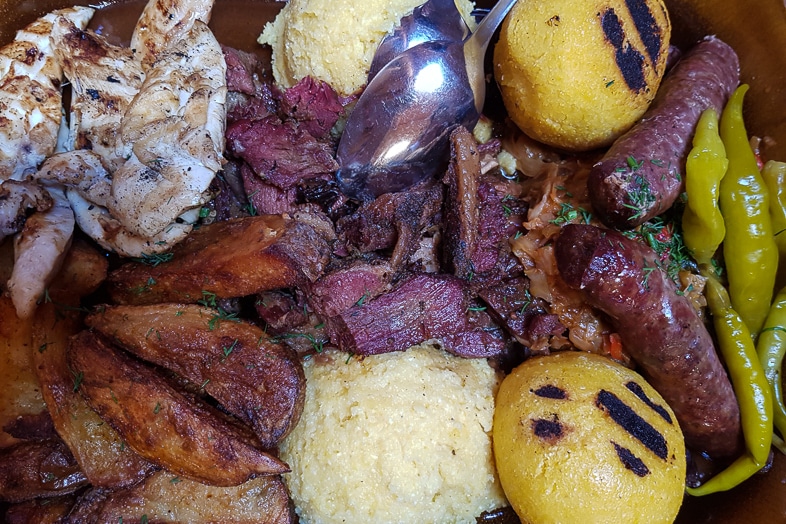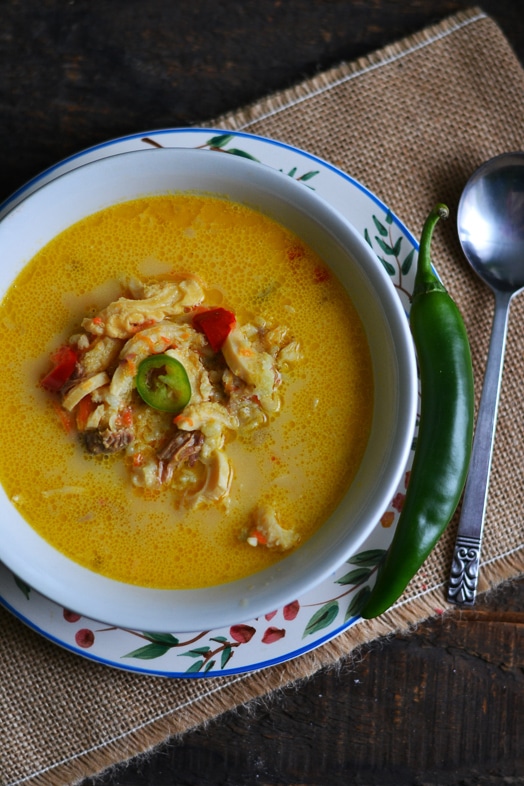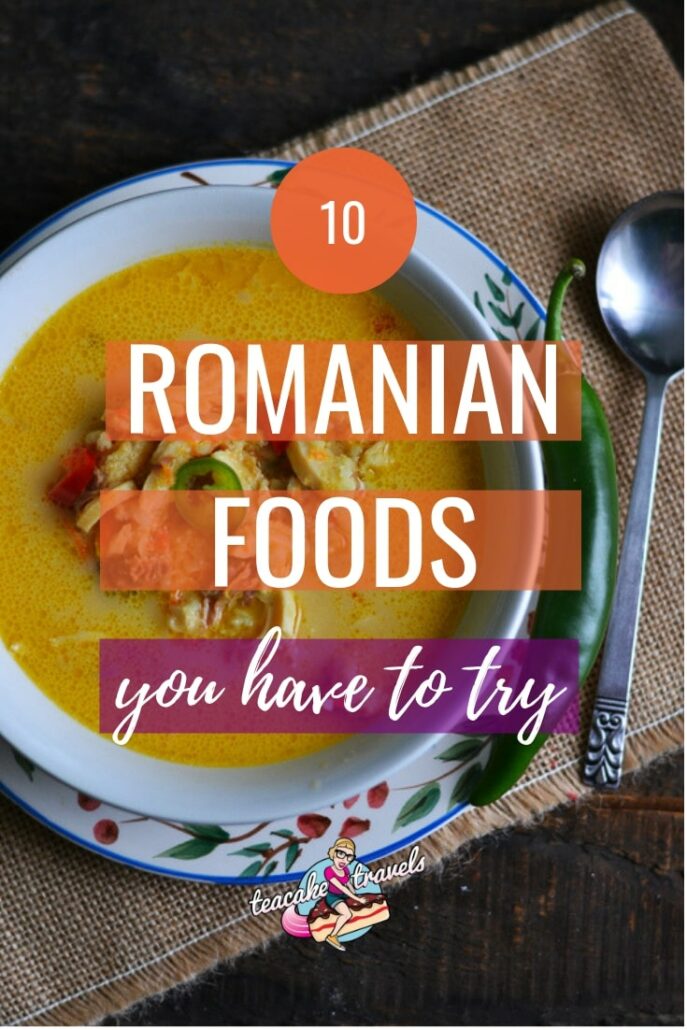When traveling in Romania, it’s easy to get distracted by all the different choices when it comes to Romanian food. Romanians are generally great cooks, and there are a lot of national dishes we take great pride in.
10 Delicious Romanian Food Dishes You Must Try
To help make sure you get the best and most culturally meaningful food experience, here are the top 10 foods you have got to try when visiting Romania!
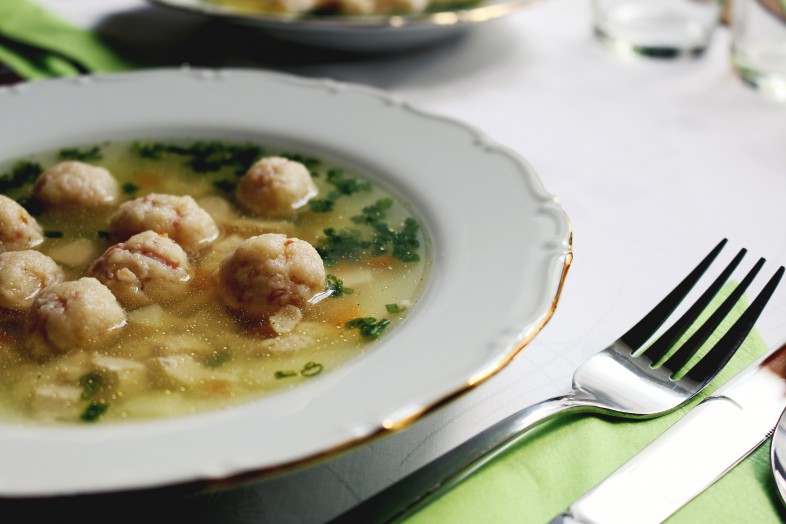
Sarmale
This one is a no-brainer. A happy remnant from our brushes with the Ottoman Empire throughout history, and a favorite among Romanian dishes, sarmale have become a pillar of Romanian cuisine. No Christmas dinner is complete without them. Similar forms of this dish exist throughout the Mediterranean and Eastern Europe, although I like to think that Romanians have perfected the formula.
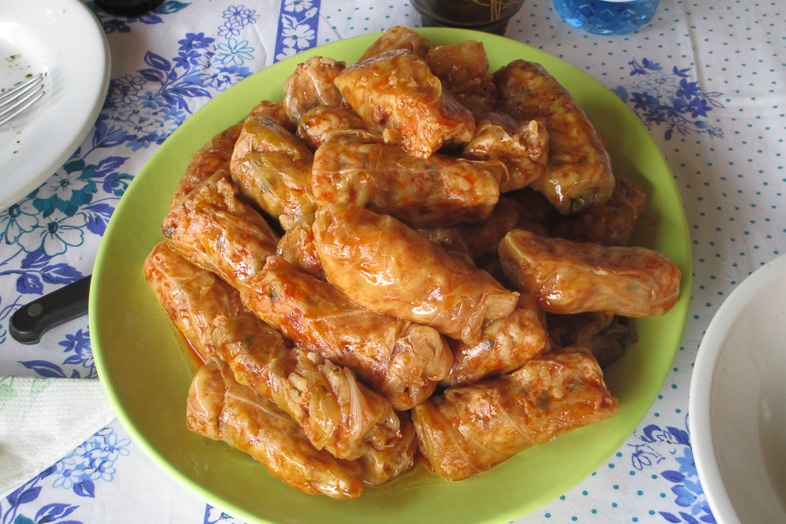
Sarmale are made of a mix of minced meat—usually a combination of pork and beef—and rice, stuffed inside pickled cabbage leaves, boiled, and served with sour cream. If you enjoy Greek food, you may have tried Greek dolmadakia. These look similar, but are actually quite different once you familiarize yourself with both recipes.
The difference between Greek Dolmadakia and Romanian Sarmale
Firstly, Greek dolmadakia are wrapped in vine leaves, not cabbage. Sometimes you do find sarmale wrapped in vine leaves, but the cabbage rolls are considered “more Romanian”.
Secondly, Greek cuisine offers a vegetarian option for these yummy rolls, stuffed only with rice and herbs, while Romanians would shudder at the thought of vegetarian sarmale. It would seem almost blasphemous. I can confidently say that in 20 years of life as a Romanian, I have never once encountered a vegetarian sarma. They may be out there, but I have a rule that if it would offend my Grandma, I can’t eat it.
Granted, the obsession with meat in the Romanian diet probably isn’t all that healthy, but in this case we have to stick to our guns.
Mămăligă
Now that I’ve made a strong case against vegetarian sarmale, it’s time to introduce a dish that can, in fact, be served without meat. Mămăligă is the Romanian word for polenta, or cornmeal porridge. It is such an important food in Romanian culture that there’s a funny, though somewhat sexist, saying that a girl can’t get married if she doesn’t know how to make mămăligă! That must be why I’m still single.Anyway, it’s not uncommon for wedding gifts to include a special mămăligă-making pot. At mealtimes, if it’s not served with bread, then it’s served with mămăligă, so this is seen as a staple food item for families.
Although in theory it should be easy to just put some cornmeal in a pot with some salt and water and boil it, in practice there’s a lot more that goes into getting the right consistency and getting all the lumps out.
My godmother says you need to listen to the mămăligă—it will tell you when it’s ready. My mom’s other best friend says you need to stir it one hundred times.
Some people are fans of letting it burn a little on the bottom of the pot to get some nice crispy bits in there. My mom once made mămăligă pancakes, and they were pretty good!
How to serve mămăligă
There are a lot of ways to make mămăligă and equally many ways to serve it! The way my family most frequently eats it—and our favorite vegetarian (but not vegan) mămăligă option—is with a big mix of dairy products. You take a couple dollops of hot mămăligă, and first you melt a chunk of butter into it. Then, you fill your plate with different cheeses, yogurt, and sour cream, mix them all in with the mămăligă, and enjoy.
Our second option is a little meatier—it’s called “Taci și-nghite”, which literally translates to “shut up and swallow”. I’ve decided not to remedy the previous sentence by trying to take the dirty references out of it. Moving on…Taci și-nghite is mămăligă covered in cheese, bacon, and a few cracked eggs, baked in a pan. It gets its name from the fact that it’s so delicious, you have no choice but to be quiet and just get on with eating it.
For a final serving option, I’ve been informed that a good thing to do with mămăligă leftovers is to pretend they are breakfast cereal and eat them with milk and sugar. I’ve never tried it, but apparently this is a thing. I have yet to decide how I feel about it.
Sibiu Salami
“Salam de Sibiu” is the national standard for cold cuts. I’ve never personally been to Sibiu to try it fresh from the source, but this is by far the best salami I have ever tried. Densely packed and very salty, it’s a pork salami that’s good to eat with bread and butter, or with some delicious Romanian tomatoes.
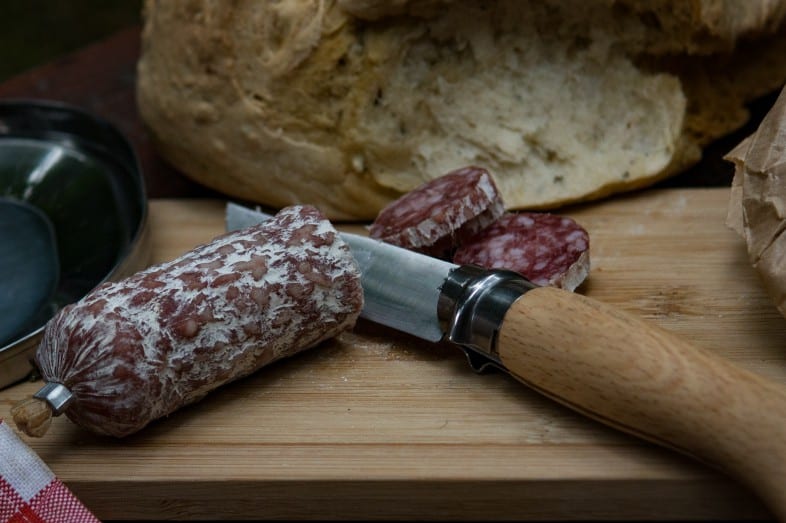
The spirit of being a responsible tourist dictates that you really should visit Sibiu and try it there, but this salami is distributed to every supermarket and fresh market in Romania.
READ: 30 Unmissable Things to do in Romania
If Sibiu is not on your travel itinerary, you can definitely pick it up at the corner store closest to your AirBNB. Make sure you peel off the powdery skin before you eat it!
New to AirBNB? Get money off your first stay here!
Ciorbă de burtă
Romanians love soup. Every important celebratory meal must have a soup, and it’s also a staple for typical Romanian family meals. There are two very different kinds of soup you can try in Romania—a “supă” which is a regular soup, and the more “Romanian” option, the “ciorbă”. Tripe soup, or “ciorbă de burtă”, is the latter.
The difference between supă and ciorbă is that, while supă is made like a regular soup with vegetables, meat, and salt, the ciorbă is made more flavorful with a sour note, usually accomplished by using borș. Ciorbă de burtă is an exception to this rule. Instead of being made sour with borș like most other ciorbe, the sourness in this Romanian soup comes from vinegar—either white wine vinegar or apple cider vinegar.
The star ingredient in this soup is cow stomach, or tripe (which doesn’t sound like the most appetizing cut of meat) but if you don’t think about that part too much, you’ll find this dish is really tasty. The soup has a creamy texture and a yellow color. You can add more vinegar to suit your taste, and of course, this soup isn’t complete without a scoop of sour cream (and a spicy pepper, my mom adds).
Mici
Ah, the promising smell of burning charcoal: it’s barbecue time! And in Romania, every barbecue has to include mici. Romanian mici, or mititei, which literally translates to “little ones”, are a very simple but delicious dish. Essentially, they are a mix of minced beef and pork, with some herbs and garlic mixed in. They are grilled on the barbecue and served with bread and mustard.
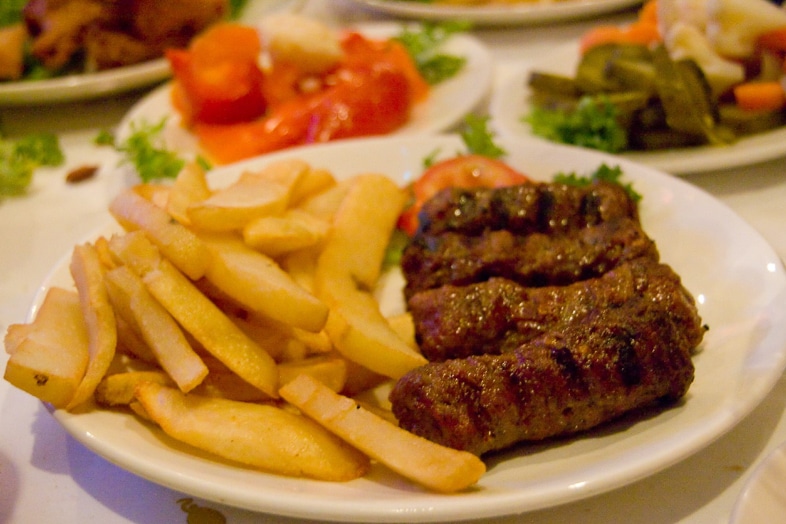
You’ll easily find food stands and small restaurants selling them in parks, on the beach in Constanța, and at any fair. They are a great snack to pick up in between activities, and go really well with a pint of Ursus beer. Besides, sitting down with a beer and some mici seems like a perfect opportunity to mingle with the locals.
Salată de Vinete
Another dish with a strong Mediterranean feel, salată de vinete, or eggplant salad, is the first vegan-friendly food on our list. This isn’t a salad in the traditional way that one might envision a salad—it’s more like a dip, or a spread. The eggplants are grilled, then the contents scooped out and mashed into a mix together with chopped garlic or onion, salt, pepper, and oil. It is then spread on bread, or eaten alongside other vegetables.
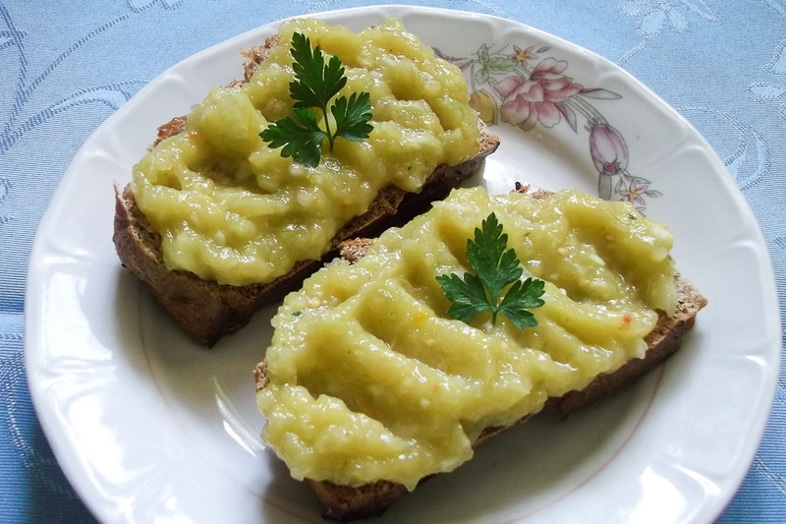
To me, a great evening snack looks like a plate with a slice of bread, a couple scoops of eggplant salad, a delicious Romanian tomato fresh from the market, a few olives, and a slice of salty cheese.
Vișinată
Christmas in Romania is a time for family, food, and fun and fun entails “alcohol”.
Maybe I’m exaggerating a little bit, but who doesn’t love a nightcap on Christmas Eve? That’s why this Romanian drink is prepared months beforehand to be ready to help us celebrate and warm up in the winter.
Vișinată is an amazing, rich black cherry liqueur. It’s fairly simple to make, but patience is required to let it reach its peak flavor. Once the black cherries, or vișine, have been picked in the summer, many of them are saved specifically for the purpose of making vișinată. Bottles or jars are then filled halfway with black cherries, and an equal amount of sugar by weight.
The mix is left to ferment for a few days before the container is filled with some really strong booze which is either vodka or a traditional Romanian drink called țuică, a plum brandy that is equally important in Romanian culture. After this process, the vișinată is left for about three months, occasionally being jostled around a bit to make sure everything gets mixed together well to get the best flavor.
What I love about vișinată is that the resulting drink is deceivingly sweet and tasty. I don’t drink țuică or any other spirits because they’re too strong and burn on the way down, but while vișinată is just as strong, it tastes much better and you really don’t realize how drunk you’re getting when you drink it because you don’t expect something that tastes so good to go to your head so quickly!
Of course, this can be a good thing or a bad thing depending on your own level of self-control and self-awareness, but as a rule I probably wouldn’t drink more than three shot glasses worth of vișinată in one sitting.
You can always swap this saccharine treat for a glass of good old-fashioned Romanian wine.
As a final note, the boozy cherries left over from making vișinată are, of course, not allowed to go to waste.
Instead, they are used as toppings for cakes and other desserts, or just eaten alone by cheeky invaders who wander into Grandma’s kitchen.
Papanași
There are a lot of great Romanian desserts out there to try, and also desserts from other backgrounds—like the Hungarian Kürtőskalács (more about that later)—that are commonly found in Romania. But the great thing about papanași is that they are this sort of universally satisfying guilty pleasure, and are found in any kind of Romanian restaurant, from the humble poolside restaurant, all the way to fancy bistros. A former partner who spent a week in Romania with me said this was the most memorable thing he ate during our trip.
Papanași are a towering monstrosity of a donut, with the eternally elusive donut hole included on top. Some restaurants I’ve been to serve them in pairs, which seems delectably irresponsible. There’s none of that artificial flavoring, glaze and sprinkles nonsense going on here.
This is a dessert that anyone should be able to make at home.
What makes them so rich and delicious, and sets them apart from other kinds of donuts—something I only discovered today while looking up recipes—is that the batter is made with cheese. Cheese! In donut batter! I don’t know how I missed it!
They are inhumanly good. Unlike most Romanian foods that include cheese, this one does not use salty cheese, but rather a more mildly flavored option, like cottage cheese.
The batter is deep-fried to form a donut and a ball that fits on top of the donut hole, and then the entire thing is drizzled with jam and sour cream. Delicious!
Stuffed Bell Peppers
There are a lot of similarities between Eastern European food and other cuisines from around the world. Romanian recipes have been influenced by many different cultures, and that’s why this next traditional Romanian food may seem familiar—it can be found in many different forms around the world, but as always, there are subtle differences that make this recipe unique.
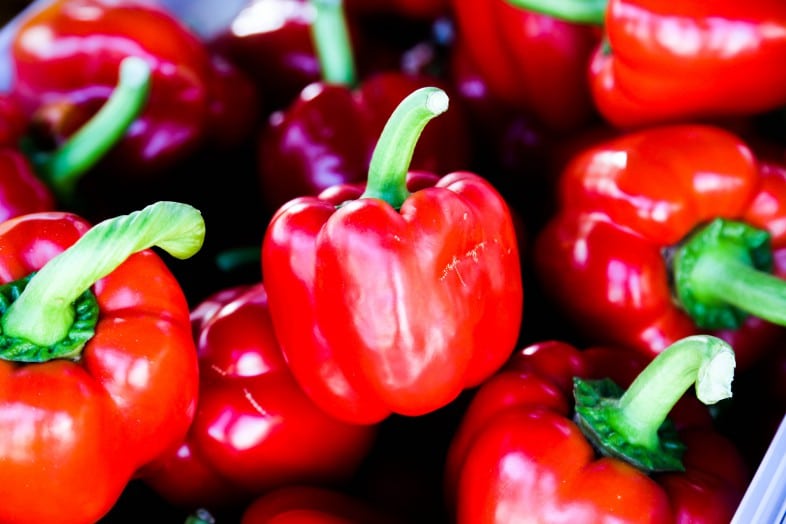
Stuffed bell peppers, or “ardei umpluți”, are one Romanian food that I can never say no to. They are very filling and satisfying, but not so overly heavy that you feel like you can’t move afterwards. Once the stem and seeds have been carefully cut out to preserve as much of the bell pepper as possible, they are then stuffed with a mix of minced pork (sometimes combined with beef as well), rice, herbs, and onion. They are then boiled in a delicious tomato sauce.
The trick to getting the perfect flavor is to make sure to add a bit of sugar to give the sauce some sweetness to it. And of course, as with every other popular Romanian food, this dish is always topped with sour cream to serve.
Kürtőskalács
The last item on this list is a bit of a cheat, I’ll admit. This is actually a Hungarian food, but is a favorite street food in Transylvania, and in Hungarian-speaking parts of Romania. You can probably also find it in Bucharest, though I’ve never had such luck myself. It’s also a food you will generally find in any areas meant for fun, like beaches, food festivals, and at the medieval festival in Sighișoara.
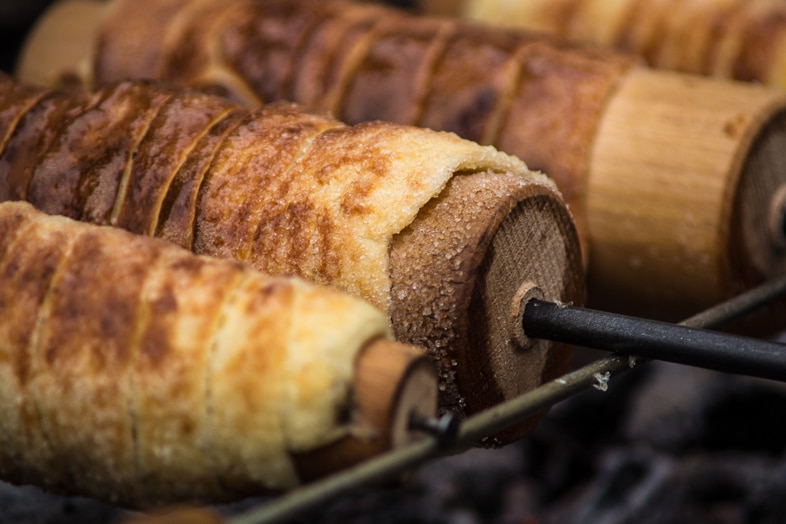
Kürtőskalács are a Hungarian spit-cake. A long strip of sweet dough is wrapped around a baking spit, and brushed with egg yolk and/or butter for a glossy finish. Nowadays they come in many different flavors, as toppings are spread on the surface before the kürtőskalács are baked over charcoal. You can get a plain granulated sugar topping, cinnamon, walnut, coconut flakes, and more.
To eat it, you just grab one end of the dough and tear off a piece. The spiral shape of the dough makes it easy to eat without having to cut a slice with a knife. Just pull gently, and tear. The entire thing will be gone sooner than you know.
Quicks Romanian Food FAQs
Is Romanian food good?
Categorically, yes. It’s rich, packed with flavors, and made with a sense of responsibility for representing our country and our culture. If you ever happen to come across “bad” Romanian food, blame the restaurant, not the food or culture itself.
Is Romanian food spicy?
While we do use a lot of spices, and sometimes serve with spicy side dishes, most traditional Romanian foods lean more towards being salty and/or sour. We do use a lot of garlic in sauces and dips, though, so you will find dishes that are spicy from the use of garlic or onion, but not that many dishes with chili peppers and such, although there are some of these as well.
Is Romanian food healthy?
The most traditional and well-loved Romanian dishes do tend to revolve around a lot of meat, dairy, carbs, salt and oil, so if you do want to experience as many traditional dishes as possible in a short space of time, you’re probably not going to be eating the most healthy or balanced diet. That being said, Romanian families don’t always eat like this.
Romanian fruit and vegetable produce is very good and high quality—if you happen upon a fresh market in the summer, I highly recommend trying the watermelon and the tomatoes. Many parts of the country are still very old-fashioned in their entrepreneurial spirit, so when you’re on a road trip passing through small villages, you’ll often find people selling their own home-grown organic fruits and vegetables, and sometimes eggs as well.
Somewhere near my hometown there’s even an ostrich farm selling ostrich eggs! Even children from poor families sometimes make a bit of pocket money out of selling wild raspberries, blackberries, and red currents that they pick from the forests.
Point being, there are a lot of great fruit and vegetable options available in Romania, so the choice to make a good salad is always there, but it really depends on the individual family’s sense of responsibility and priorities when it comes to their eating habits.
At the end of the day though, we have one major statistic behind us, which is that, despite eating comparatively much fewer greens, Romania is actually said to be the EU country with the lowest rate of obesity in adults (depending on the source)—with big improvements made in this area since a decade ago. As a country, we must be doing something right.
Where can I buy Romanian food?
This one is a little more tricky, because Romanian cuisine is not as well-known globally as cuisines from other countries, so it’s harder to find if you’re not actually in Romania itself. When I lived in China, I loved eating at Greek and Iranian restaurants, because the food was the closest thing that could remind me of home.
However, China is a big place with not that big of a Romanian population overall. But with an estimated 8 to 12 million Romanians living outside of Romania, you can bet that there are many cities in which you can find Romanian restaurants or Romanian food supply shops that import favorite Romanian ingredients for the local Romanian immigrants to use.
A quick Google search presents options for Romanian restaurants in Rome, London, Barcelona, Paris, Anaheim, Long Island, and many more. If you’re in a country with a lot of immigrants, you can bet there will be some Romanians among them who missed home too much to resist the urge to open a Romanian restaurant.
What are some famous Romanian drinks?
In the article I’ve mentioned a lot of favorites—vișinată (black cherry liqueur), țuică (plum brandy), and Ursus beer. Romanian wine is also known for being very good, some insist even better than French or Italian wine, although I’m really no wine expert so I have no idea what to recommend. One last drink that I really love is Romanian eggnog, which is called “lapte de pasăre”, meaning “bird milk”, though this is more of a “Grandma makes it for me when I have a sore throat” kind of drink, and isn’t served in a lot of restaurants. However, for another nice, warm drink, Romanians also make a mean mulled wine, which you’ll easily find being sold by vendors at Christmas markets if you’re ever visiting Romania in the wintertime.
Did I leave out your favorite Romanian food dish?
That’s it for this Romanian food guide. Whatever you eat while you’re in Romania, I’m sure it’ll be worth your while traveling to Romania, and definitely worth the extra bit of belly fat you’ll go home with.
Have you tried any of these Romanian delicacies? What are your favorites? Share your favorite Romanian food dishes with us!
Wanna make your own Romanian food?
Try these 7 easy Romanain food recipes
Comment Below
Tell me what you think and share your favorite food destinations and other tips about Romania!
Related Reading
7 Easy Romanian Recipes My Grandma Makes
How to visit Dracula’s Castle in Romania

